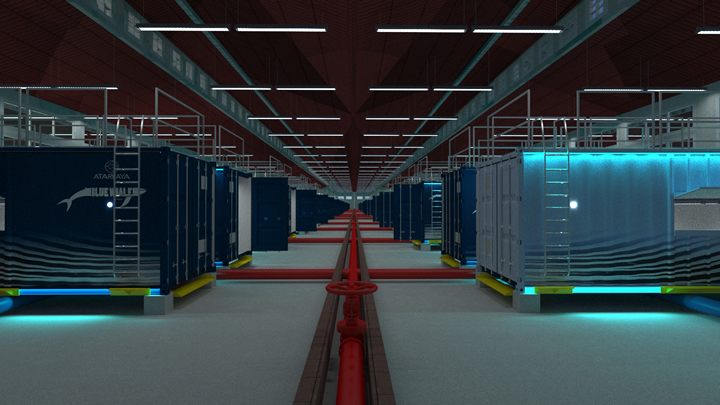Housed in Traditional Cargo Containers, New AI-Powered Shrimpbox Technology Offers Sustainable, Highly Profitable and Globally Scalable Protein Source

INDIANAPOLIS and MEXICO CITY - Atarraya, creator of Shrimpbox, the first sustainable ‘plug-and-play’ shrimp farming technology and the aquaculture equivalent to agriculture’s vertical farming, today announced its U.S. launch. Housed in traditional cargo containers that can be located anywhere — even in landlocked, urban areas — a Shrimpbox farm can be moved or scaled up according to production needs. Shrimpbox’s AI-powered automated system remotely monitors water quality, regulates temperature and oxygenation and feeds the shrimp. Shrimpbox offers farmers a viable new revenue source that delivers up to 10 times the ROI of poultry or swine farming and overcomes many of the challenges associated with traditional farming, including cost and environmental impact. View a short video of Atarraya’s Shrimpbox technology here.
“We’ve spent the past 10 years diligently working to bring Shrimpbox to market and are now ready to begin rolling it out at industry-level scale,” said Daniel Russek, CEO and founder of Atarraya. “Our proprietary technology decreases the environmental impact and cost of traditional shrimp farming or trawling. It allows for the production of fresh, sustainable and local shrimp farms to be set up anywhere in the world as a vertical aquaculture farm that generates nearly 10X the return on investment to farmers.”
Shrimpbox integrates the best biotechnology, software and hardware to produce fresh shrimp sustainably:
- Biotechnology: Shrimpbox utilizes biofloc technology that emulates how shrimp grow in the oceans. Biofloc nourishes a microbial ecosystem that provides an environment in which the shrimp are protected and able to mature — with minimal need for water discharge. The biofloc system eliminates the risk of disease and the need for antibiotics and other harmful chemicals, creating better genetics that enables the shrimp farming industry to become vertical aquaculture farming.
- Software: Allows for remote management of production units without the need for specialized personnel. All relevant workflows can be mapped to deal with data complexity. The use of software also enables consistency, remote control of the network and makes it easy to train and perform farming tasks and operations.
- Engineering and Automation: Designed to ensure consistent production and economic viability, even in countries with high labor costs. Enables fast reaction times, tighter controls and minimizes labor costs. Automated systems make it possible to remotely monitor water quality, regulate temperature and oxygenation and feed the shrimp. AI-powered, plug-and-play technology allows anyone — even those with no prior farming or aquaculture experience — to become a shrimp farmer.
The first Shrimpbox prototypes, assembled in the coastal community of Guapinole, Oaxaca, Mexico, are already in operation. A Shrimpbox farm for training and demo purposes is also slated to open later this year in partnership with the State of Indiana’s IEDC (Indiana Economic Development Corporation).
Shrimp sales volume increased from 275 to 415m pounds in the past five years. Unfortunately, the staggering demand for shrimp has a downside: environmental impact and labor issues. Trawling for shrimp in the ocean degrades or destroys delicate seabeds, which take years to recover. Existing shrimp farms require enough water for a city of 500K and often contaminate groundwater. Work conditions for shrimpers in many countries are harrowing. Atarraya converts shrimping’s outdated production and business model with an eye to environmental balance, while also ensuring consumers have a consistent source for sustainable, locally produced, fresh shrimp.
Atarraya recently raised a $3.9M Series A funding round at a post-Series A valuation of $41M. The Series A funding was led by Jeffrey Horing and other angel investors, including Mark K. Gormley, Geoffry Kalish, Robert Stavis, and Robert Goodman, and brings Atarraya’s total funding to date to $10 million. Atarraya will use the new funds to scale its proprietary Shrimpbox technology globally and to launch its U.S. headquarters in Indianapolis.
“Shrimpbox produces real shrimp — the kind customers crave. The shrimp are not cultivated in labs or grown from stem cells. They are identical to wild shrimp because Shrimpbox mimics the ideal breeding environment of wild shrimp in the ocean,” said Geoffry Kalish, angel investor and board member. “Investing in Atarraya was an obvious choice. Shrimpbox offers the rare chance to do the right thing for the environment, meet consumer demand and opens up new possibilities within farming and aquaculture.”
Contact info@atarraya.ai or visit https://www.atarraya.ai to learn more.
About Atarraya
Atarraya is on a mission to make shrimp the sustainable protein of the 21st century. Powered by AI, Atarraya’s proprietary Shrimpbox is a true “plug and play'' sustainable shrimp farm that transforms aquaculture by using the most advanced biotechnology, software and hardware available. Atarraya’s Shrimpbox technology was developed over the course of the past 10 years by a team of engineers, biologists, and developers from Mexico, Norway, Brazil, Argentina and Poland. Atarraya’s holdings include Maricultura Vigas, a sustainable aquaculture production company with a decade of shrimp farming experience utilizing biofloc technology that minimizes the use of water and eliminates the necessity of antibiotics and harmful chemicals.
Based in Mexico City and Indianapolis, Atarraya is a privately held corporation backed by Jeffrey Horing, Mark K. Gormley and other angel investors. Follow Atarraya on YouTube, LinkedIn and Twitter, or learn more at https://www.atarraya.ai.
Comments (0)
This post does not have any comments. Be the first to leave a comment below.
Featured Product

